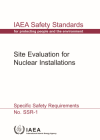Among the IAEA’s key publications are its Safety Standards, which provide the fundamental principles, requirements and recommendations to ensure nuclear safety. They serve as a global reference for protecting people and the environment and contribute to a harmonized high level of safety worldwide.
Safety standards
Activities such as the medical uses of radiation, the operation of nuclear installations, the production, transport and use of radioactive material, and the management of radioactive waste must be subject to standards of safety.
The prime responsibility for nuclear safety must rest with the person or organization responsible for these activities. Regulating safety is a national responsibility. However, radiation risks may transcend national borders, and international cooperation serves to promote and enhance safety globally by exchanging experience and by improving capabilities to control hazards, to prevent accidents, to respond to emergencies and to mitigate any harmful consequences.
The IAEA is required by its Statute to promote international cooperation. Its Statute authorizes it to establish or adopt safety standards for the protection of health and to minimize the danger to life and property. The Agency develops such standards on the basis of an open and transparent process for gathering, integrating and sharing the knowledge and experience gained from the use of technologies and from the application of the Safety Standards themselves.
The Safety Standards consists of three sets of publications: the Safety Fundamentals, the Safety Requirements and the Safety Guides. While the first one of these establishes the fundamental safety objective and principles of protection and safety, the second set out the requirements that must be met to ensure the protection of people and the environment, both now and in the future. The Safety Guides provide recommendations and guidance on how to comply with the requirements.
The users of safety standards in Member States differ depending on the category of safety standards. The principal users are the regulatory bodies and other relevant national authorities. The safety standards are also used by joint sponsoring organizations, by organizations that design, manufacture and operate nuclear facilities, as well as by organizations involved in the use of radiation related technologies.










